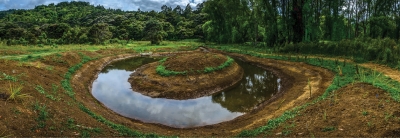A pond for pateke
Te Henga wetland, which covers 160 hectares and is the biggest in Auckland, has the potential to be the ideal wildlife habitat with acres of reeds, raupō, sedges, open water ponds and the Waitākere River coursing through it.
Forest & Bird’s project Habitat te Henga was born from a desire to protect the
wetland. It started in 2014 with intensive stoat control, using 100 DOC 200 traps, several A24s and some cat traps.
Two trap lines totalling 30 kilometres were regularly checked and reset by a dedicated trapper. Scores of DOC 200s and A24s have been added since.
Effective predator control was required before translocation of pāteke could be considered and the first contingent of 20 pāteke was released in 2015, with a survival rate of 80 per cent, leading to another release of 80 birds in 2016. This has been covered previously in Flight magazine.
This success brought us closer to that ideal habitat and aroused interest and support from the local community and a range of other organisations.
Matuku Reserve Trust Board was established when the last block of bush and wetland came up for sale. The trust was able to buy it in November 2016.
The property, at the head of the Te Henga wetland in West Auckland, has raupō
and sedge beds, and open water ponds along the meanders of the former course of the river.
There are remnant pukatea and kahikatea at the foot of mixed kauri-podocarp-broadleaf forest from which small streams and seeps enter the flats.
With several other conservation projects including the Ark in the Park, Habitat
te Henga, and Forest & Bird’s Matuku Reserve alongside it, the 37-hectare property has been named Matuku Link. Here, a nursery has been established providing most of the plants that are converting the kikuyu-covered flood plain into a range of wetland habitats. An old barn has been transformed and provides not only a volunteer base but already does duty as a site for wetland education to the many school, service, business, and community groups that help with planting and bird releases. An aim is to have an on-site educator to work with schools.
Dozens of local residents have become involved as part of a buffer zone, collecting their traps or bait from the barn and local interest is really heightened when, as has happened in the past two years, pāteke have bred in their ponds or streams.
Also exciting for our neighbouring conservation group to the north was their discovery last year of a pāteke pair that had dispersed several kilometres into the forest-clad stream that disgorges into the te Henga wetland.
New ponds have been constructed at Matuku Link, with one of them sporting a family of seven pāteke ducklings. A more established pair on an existing pond are
so placid and accommodating that almost all visitors get to see them plus or minus their ducklings.
A further new pond was part of a survey for a PhD study on ponds and sampling from its inception over the year showed that it only took five to six months until
the Macroinvertebrate Community Index (MCI) matched that of established ponds. The MCI measures water quality.
Measuring outcomes for wildlife with predator control in place has involved
biennial audio recordings for matuku and pūweto. Pūweto are also surveyed annually. Goodnature A24 traps were deployed 18 months ago between an
existing DOC 200 array to see if a benefit to wildlife could be shown using pūweto as an indicator species.
The DOC 200 traps have been in place for six years and with the recording of fortnightly trap catch data and sightings or detections of matuku [bittern], pūweto [crake] or pāteke, we have a basis to see if change is detectable.
Rodent monitoring is undertaken three times a year by Auckland Zoo staff as part of its Conservation Fund outreach.
Native freshwater fish present include both long finned and short finned tuna, and one stream surveyed also had Cran’s bully, common bully, banded kōkopu and an unidentified galaxiid. These surveys have been done by Whitebait Connection which has also tested water quality parameters. Testing showed high health
of the river and streams.
A second forest-covered stream surveyed showed only eels and kōura but the
presence of a large overhanging culvert is the likely cause of the difference. With Whitebait Connection’s help, a fish ladder has been constructed and followed by
repeat surveying.
At other sites, galaxiids have wasted no time in colonising upstream once
impediments are removed and we also trapped a banded kōkopu upstream of
the culvert within a fortnight.
As well as continuing to use G-minnow traps, we will be taking water samples
to test for eDNA (environmental DNA). Multi-species testing of DNA in the
water will show what fish we have but it is also possible our streams have Hochstetter’s frog and Latia, the native limpet [the world’s only mollusc with bioluminescence].
The rest of the wetland is privately owned, but access to see wetland
habitats is now possible at Matuku Link. River flats make for easy walking but
accessibility for wheelchairs and buggies is being enhanced with good surfaces
and our first boardwalk has its official opening at our World Wetlands Day event in February 2021.
Building this boardwalk and other infrastructure was made possible by the post-Covid Jobs for Nature scheme. Our World Wetlands Day event is one of two open days we usually hold each year but now the barn is finally renovated, we
expect to open more frequently.
The annual kayak trip down the river offers visitors an intimate view of a large healthy wetland as well as being a great fundraising event. This year the event
will be on Saturday, April 27.
Our newest pond, made possible by Ducks Unlimited NZ, is slowly filling and once the plantings are established, we look forward to seeing pāteke and other wetland birds using it.
For more information, visit www.matukulink.org.nz and www.facebook.com/matukulink.
Image Gallery
https://ducks.org.nz/flight-magazine/item/401-a-pond-for-pateke#sigProId194b906ea4


